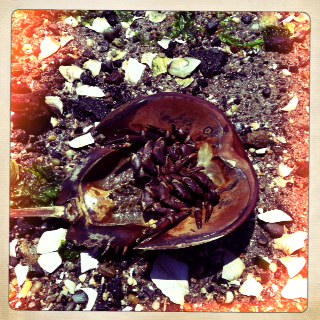Kingdom Animalia Phylum Arthropoda Class Merostomata Order Xiphosura Family Limulidae
Genus Limulus Species Limulus polyphemus
 |
| photo by alex rex - http://www.flickr.com/photos/aliasrex/5820249834/ | |
The horseshoe crab is a fascinating species. Horseshoe crabs have been around for an estimated 300 million years and are thought of as “living fossils”. Aside from that, they have hardly changed throughout this lengthy timeline. I have never seen a horseshoe crab alive but have come across many of their shells along the shore. I chose this creature because of its unique characteristics and history.
They are found along the western Atlantic and the Gulf of Mexico. Horseshoe crabs largely populate the Delaware Bay. They live in shallow ocean water along the soft, muddy bottom. To avoid predators, they are mostly active at night. Horseshoe crabs bury themselves in the sand during high tide and resurface mostly during low tide.
There are 4 different living species of horseshoe crabs. The Limulus polyphemus is the only one found in the Atlantic region and the Gulf of Mexico. The others are found in S.E. Asia. (1) Carninscorpius rotundicada, 2) Tachypleus gigas, 3) Tachypleus tridentatus (www.marinebio.com)
 |
| www1.appstate.edu |
- Their hard shell protects horseshoe crabs. They shed their shell numerous times during their life span. After the age of 3-4 years, horseshoe crabs molt only once per year.
- They have 2 large, compound eyes and a number of tiny eyes along the carapace.
- They have 5 pairs of legs that they use for getting around and to put food into their mouths.
- Their mouth is located at the base of their legs and covered with spiny bristles that aid in pushing the food into the mouth.
- In addition to using their rigid tails to flip back over, they also use their tails to dig in the sand.
- Females are larger that males. The Atlantic H.C. (Limulus polyphemus) can grow up to 24 inches long. Young horseshoe crabs grow larger each time they molt.
- It takes 8 to 10 years for an adult to develop.
- Their food sources include worms, mollusks, crustaceans, some smaller fish, and algae.
Breeding:
 |
| photo by bill hubick, www.billhubick.com |
- Breeding season is each spring during high tides along with new and full moons.
- During this season, horseshoe crabs migrate to shallow coastal waters.
- Males select a female mate by clinging onto their back.
- The females dig a hole in the sand and lay their eggs while the male fertilizes them.
- The female can lay up to 20,000 eggs. The eggs then take about 2 weeks to hatch.
- The eggs are an important food source for many migratory birds.
Predators:
 |
| www.dnr.state.md.us |
- Aside from shorebirds eating eggs and juvenile horseshoe crabs, the main cause of death is overfishing. Horseshoe crabs are used by fisheries as bait for the American eel and conch. This trend has caused a decline in the species. Within the last decade, restrictions have been put in place against their use for bait and biomedical purposes. (http://marinebio.org)
- Before artificial fertilizers were created, horseshoe crabs were captured, dried, and used as fertilizer. This also caused significant decline in the number of horseshoe crabs along the Atlantic.
- Urban development along the shorelines has aided in the decline of this species. This type of development causes pollution, change of habitat, and overall changes to the horseshoe crab’s ecosystem.
- Horseshoe crabs are currently listed as Lower Risk/near threatened. Many fear that with the decline of horseshoe crabs, a large disruption in its ecosystem will occur. This has already led to a decline in the migratory shorebirds that feed off of their eggs.
- Though many think of them as crabs, they are actually more closely related to spiders, scorpions, and belong to a subphylum known as chelicerata.
- “Horseshoe crabs can swim upside down in the open ocean using their dozen legs (most with claws) and a flap hiding nearly 200 flattened gills to propel themselves” (www.horseshoecrab.org).
- A hard shell protects their entire body. As long as they aren’t flipped over, this shell protects them from shorebirds and other predators.
- If upside down, they use their long, straight tails to help flip them over.
- Horseshoe crabs are survivors. They can go up to one year without food and can survive in extreme temperatures and salinity.
- They have been a great help to the medical world. “The medical profession uses an extract from the horseshoe crab's blue, copper-based blood called lysate to test the purity of medicines. Certain properties of the shell have also been used to speed blood clotting and to make absorbable sutures” (http://www.beach-net.com/horseshoe/Bayhorsecrab.html).
- Scientists have also found horseshoe crab’s eyesight to be very helpful in research for the blind, etc. “In 1967, Dr. H. Keffer Hartline received the Nobel Prize for his research on horseshoe crab vision. He discovered how sensory cells in the retina help the brain process visual cues, enabling horseshoe crabs to see lines, shapes, and borders. This mechanism, called lateral inhibition, allows horseshoe crabs to distinguish mates in murky water. Research of this type is helpful to understanding human eye diseases like retinitis pigmentosa, which causes tunnel vision and can lead to total blindness” (http://www.beach-net.com/horseshoe/Bayhorsecrab.html).
More images, art, and poems about horseshoe crabs:
 |
| Photo taken by me at Breezy Point, 7/11 |
 |
| Photo taken by me at Breezy Point, 7/11 |
|
 |
| Remnants of a horseshoe crab at Plumb Beach- photos taken by me |
















No comments:
Post a Comment